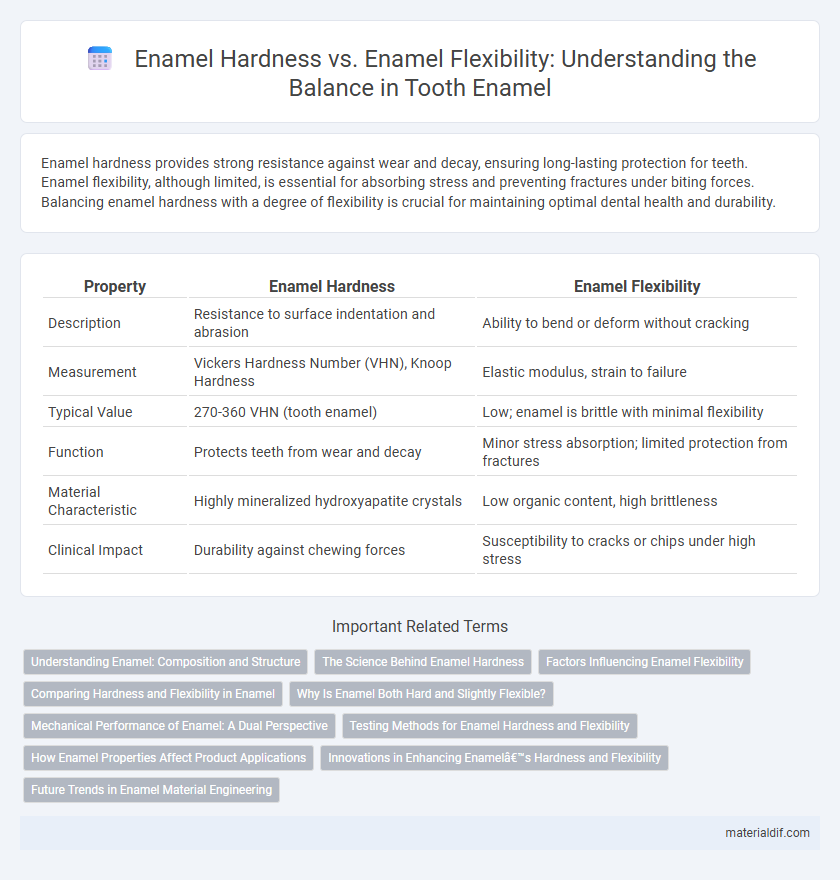Enamel hardness provides strong resistance against wear and decay, ensuring long-lasting protection for teeth. Enamel flexibility, although limited, is essential for absorbing stress and preventing fractures under biting forces. Balancing enamel hardness with a degree of flexibility is crucial for maintaining optimal dental health and durability.
Table of Comparison
| Property | Enamel Hardness | Enamel Flexibility |
|---|---|---|
| Description | Resistance to surface indentation and abrasion | Ability to bend or deform without cracking |
| Measurement | Vickers Hardness Number (VHN), Knoop Hardness | Elastic modulus, strain to failure |
| Typical Value | 270-360 VHN (tooth enamel) | Low; enamel is brittle with minimal flexibility |
| Function | Protects teeth from wear and decay | Minor stress absorption; limited protection from fractures |
| Material Characteristic | Highly mineralized hydroxyapatite crystals | Low organic content, high brittleness |
| Clinical Impact | Durability against chewing forces | Susceptibility to cracks or chips under high stress |
Understanding Enamel: Composition and Structure
Enamel's hardness derives from its high mineral content, primarily hydroxyapatite crystals, which provide exceptional resistance to wear and mechanical forces. Its structure, consisting of tightly packed enamel rods arranged in a complex interlocking pattern, contributes to limited flexibility, making it highly durable but brittle. Understanding enamel's composition and microstructure is crucial for innovations in dental treatments aimed at preserving its integrity while managing its inherent rigidity.
The Science Behind Enamel Hardness
Enamel hardness is primarily determined by its high mineral content, mainly hydroxyapatite crystals, which provide exceptional resistance to wear and decay. Despite this rigidity, enamel maintains a degree of flexibility due to the underlying dentin, which absorbs mechanical stress and prevents fractures. The balance between hardness and flexibility is crucial for enamel's durability and its ability to protect teeth during mastication.
Factors Influencing Enamel Flexibility
Enamel flexibility is primarily influenced by its mineral composition, particularly the ratio of hydroxyapatite crystals to the organic matrix, which affects its ability to absorb stress without fracturing. The thickness and microstructure of enamel rods also play a crucial role in balancing hardness and flexibility, allowing enamel to resist wear while maintaining resilience. Environmental factors such as pH levels and exposure to fluoride can alter enamel's mechanical properties, impacting its overall flexibility and durability.
Comparing Hardness and Flexibility in Enamel
Enamel exhibits exceptional hardness, ranking as the hardest substance in the human body, which provides crucial protection against physical and chemical damage. However, this hardness comes with limited flexibility, making enamel prone to cracking or chipping under excessive force or impact. The balance between enamel's hardness and its minimal flexibility is essential for maintaining dental integrity while ensuring resistance to wear and fractures.
Why Is Enamel Both Hard and Slightly Flexible?
Enamel is the hardest substance in the human body due to its high mineral content, primarily hydroxyapatite crystals, which provide exceptional durability and wear resistance. Despite its hardness, enamel exhibits slight flexibility because of its unique microstructure, where enamel rods are arranged in a tightly interlocking pattern that can absorb and dissipate mechanical stresses. This combination of hardness and flexibility protects teeth from fractures and damage during biting and chewing forces.
Mechanical Performance of Enamel: A Dual Perspective
Enamel exhibits a unique balance between hardness and flexibility, allowing it to withstand significant mechanical stress while preventing fracture under heavy bite forces. Its high mineral content, primarily hydroxyapatite crystals, ensures superior hardness, whereas the gradual gradient in microstructure enhances flexibility and toughness. This dual mechanical performance is crucial for protecting teeth against wear and dynamic impacts during mastication.
Testing Methods for Enamel Hardness and Flexibility
Testing methods for enamel hardness typically involve microhardness tests such as Vickers or Knoop, which measure resistance to indentation and provide precise hardness values. Flexibility testing of enamel is less common but often employs nanoindentation combined with bending or tensile tests to evaluate elastic modulus and fracture resistance. Accurate assessment of both hardness and flexibility is crucial for understanding enamel's durability under mechanical stress and optimizing dental treatments.
How Enamel Properties Affect Product Applications
Enamel hardness provides exceptional resistance to scratches and wear, making it ideal for applications requiring durable, long-lasting coatings such as cookware and industrial equipment. However, limited enamel flexibility can lead to cracking or chipping under mechanical stress or impact, restricting its use on substrates that undergo frequent bending or deformation. Balancing enamel hardness with sufficient flexibility is crucial for optimizing product performance in automotive finishes, electronic devices, and architectural panels.
Innovations in Enhancing Enamel’s Hardness and Flexibility
Innovations in dental materials have significantly advanced the enhancement of enamel's hardness and flexibility through the development of bioactive nanoparticles that mimic natural hydroxyapatite crystals. These cutting-edge technologies improve enamel's resistance to wear and acid erosion while preserving its ability to absorb mechanical stresses, reducing the risk of fractures. Emerging polymer-based composites and nanostructured coatings offer a balanced synergy, optimizing both durability and elasticity within enamel restoration treatments.
Future Trends in Enamel Material Engineering
Advancements in enamel material engineering are focusing on achieving an optimal balance between enamel hardness and flexibility to enhance durability and resistance to fractures. Emerging nanocomposite technologies and bioinspired formulations aim to mimic natural enamel's hierarchical structure, improving mechanical properties without compromising flexibility. Future trends emphasize smart enamel materials capable of self-repair and adaptability to environmental stressors, promoting longevity in dental and industrial applications.
Enamel hardness vs enamel flexibility Infographic

 materialdif.com
materialdif.com